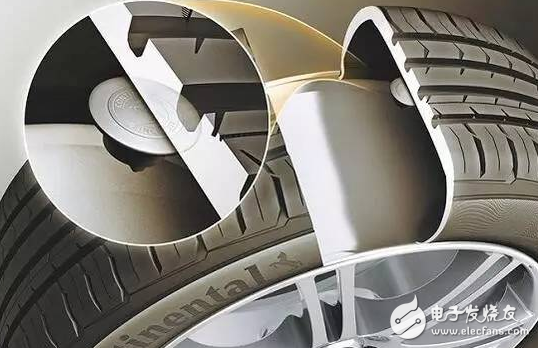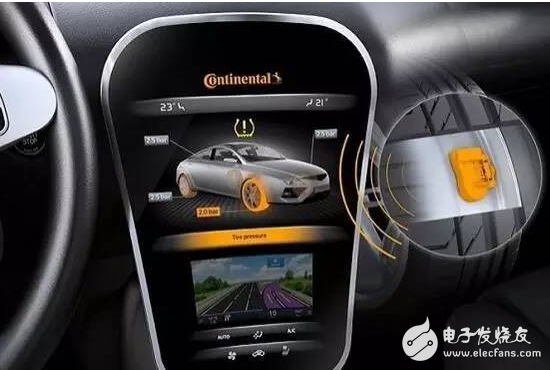A sensor called "Tire Integrated eTIS" by the Continental Group will help the German auto parts supplier update the tire pressure monitoring technology. In the future, this tire information system will become a mandatory vehicle safety standard in China.

Imagine how accurate the data provided will be when the tire pressure monitoring sensor is integrated inside the tire tread. In the near future, such technologies will be widely used in the safety configuration of vehicles.
At a recent small media conference, Continental announced details of its new generation of tire pressure monitoring technology. In the product architecture of this German auto parts supplier, an active safety system that provides similar functions is called the Tire Information System (TIS). The most important difference between this system and the traditional tire pressure monitoring system (TPMS) is the range of data collection and the way in which the collected data is processed.
The vice president of the China Group's body and safety business unit in China revealed that multinational automakers such as BMW, Volvo, Honda and Tesla are customers of Continental's tire pressure information system, while Chinese auto manufacturing such as Qirui, Qiaozhi and GAC. The relevant technology used by the business also comes from the group.

“Our system not only monitors tire pressure and temperature, but also gives more information about the tires to the vehicle,†said Dr. Yan Dongsheng, head of product management for the tire pressure monitoring system of the Continental Group's body and safety business unit. Through the information collection for each tire, the above system will display the relevant information very accurately on the display screen that the driver can see, so that the latter can control the relevant conditions of each tire in time.
The tire inflation assistance system that has been developed so far, as well as the vehicle under load information, tire mark monitoring and other functions under development, is a new skill that the supplier is about to give to the new generation of tire information systems. With the above three functions, the vehicle can provide the driver with a prompt indication of the thickness of the sidewall, the tread wear, whether the vehicle is overloaded, or even when the tire is inflated.
In addition, Continental confirmed that an app that can send tire information to mobile devices in real time is also under development. Thanks to its ability to “communicate†directly with the owner, this application will greatly enhance the ease of use and practicality of the tire information system.
It should be said that Continental has an innate advantage in the development of tire information systems. “We have both the tire business department and automotive electronics related expertise, which allows us to combine the intensive technology and experience of the two divisions in tire pressure monitoring,†said Juergen Heim.
From the working principle, the current common tire pressure monitoring system can be divided into indirect and direct. The former monitors the tire pressure by EMC (automotive electromagnetic compatibility test) or related sensors to sense the difference in tire speed. The advantage is that no additional parts are needed, which reduces the application cost, and the false positive rate is high and the individual tire abnormality cannot be given. Alerts are an obvious shortcoming.
The technology used by Continental's tire information systems is direct monitoring. This technology requires additional sensors for tire pressure monitoring, and the data collected will be more accurate and targeted.
Although direct monitoring will increase the application cost to some extent, with the improvement of R&D technology, the corresponding cost has been controlled within an almost negligible range. At the same time, direct monitoring has gradually become the mainstream adopted by OEMs.
Yang Chengzu, general manager of the Continental Group's Body and Safety Business Unit in China, gave a set of data: in Europe, the application rate of direct monitoring technology reached 70%, while in China and North America, the figure is as high as 95%.
At the moment, Continental is able to achieve direct monitoring by installing sensors at the tire valve core position. In the next step, they plan to introduce a sensor that can be directly mounted under the tire tread to enhance the accuracy and scope of the monitoring.

Qi Dongsheng introduced the application mechanism of the new sensor to the interface reporter: a small sensor can be inserted into a bladder rubber base and then fixed to the inside of the tire tread by glue. When changing tires, these sensors can be easily removed and installed on new tires.
At the same time, these sensors have no special requirements for tires and can be adapted to most tire products worldwide. “Normally, the inside of the tire is a flat rubber surface. As long as this is met, it can be installed,†explains Yu Dongsheng. He also said that there will be protrusions in the middle of some special-structured tires, which will affect the use of the above sensors to some extent.
“But a good trend is that we are calling on Europe to introduce some standards for the construction of the inner wall of the tires, which require some flat areas in the inner wall of the tires. Tire suppliers have noticed the importance of this trend and decided to reserve space for We installed it," he added.
In fact, it is never a trivial matter for a moving vehicle whether the tire pressure is within safe limits. According to a survey by the American Society of Automotive Engineers, 260,000 traffic accidents per year are associated with tire failures, of which 75% to 80% are caused by abnormal tire pressure or tread temperature. In Germany, where the automotive industry is equally developed, the incidence of similar accidents is as high as 41%.
Although the incidence of accidents related to punctures in China has reached 70%, the importance of tire safety is often underestimated by the local public. Incorporating tire pressure monitoring technology into mandatory installation by legislation may change this situation to some extent. Since October 2005, US regulators have mandated the installation of a tire pressure monitoring system for new vehicles. The EU also made the same regulations in November 2012. In Asia, Japan, South Korea and other countries as well as Taiwan, China also listed tire pressure monitoring as a mandatory standard.
Zhou Liqun, vice president of government relations for the Continental Group's body and safety business unit, confirmed that China is currently drafting relevant mandatory standards. At the same time, from the market level, the tire pressure monitoring system has achieved rapid growth in recent years, which also reflects the market demand and acceptance to a certain extent.
In addition to ensuring driving safety considerations, Continental also hopes to improve the environmental protection capabilities of vehicles with a more efficient tire pressure information system. According to the data provided by the auto parts supplier, if the tire pressure is reduced by 0.2 bar based on the conventional tire pressure standard of 2.5 bar, the fuel consumption will increase by 1%. Given China's huge car ownership base, whether the tire pressure is within a reasonable range will have a considerable impact on fuel consumption and carbon dioxide emissions. In addition, if the tire pressure is reduced by about 0.6 bar, the tire life will also be reduced by 45%.
Optical Rotary Sensor,Custom Encoder,Optical Encoder 6Mm Shaft,Handwheel Pulse Generator
Jilin Lander Intelligent Technology Co., Ltd , https://www.jilinlandertech.com